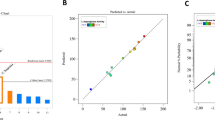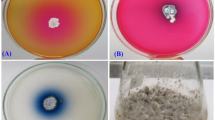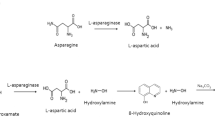Abstract
Escherichia coli L-asparaginase (EcA), a key component of a multi-drug acute lymphatic leukemia (ALL) treatment regimen, has several limitations that reduce its therapeutic efficacy. The major disadvantages include immunogenicity, serum instability, shorter half-life, and accompanying glutaminase activity that causes neurotoxicity and pancreatitis. Pegylated asparaginase and Erwinase have better therapeutic potential, but they are expensive. Using site-directed mutagenesis, we created several EcA variants by substituting specific amino acid residues at the dimer-dimer interface and B-cell epitope regions. After several rounds of screening and selection, we identified two EcA variants viz. K288S/Y176F (KSY-17) and K288S/Y176F/W66Y (KSYW-17), which showed comparable asparaginase activity to wild-type (WT) and significantly less glutaminase activity (30.36 U/mg for WT vs 1.54 and 0.99 U/mg for KSY-17 and KSYW-17). KSYW-17 was less immunogenic than WT, eliciting 4.8–5.3-fold and 2.4–3.8-fold less IgG and IgM responses, respectively. Compared to WT EcA, we also observed significantly less (~1.5-2-fold) binding of these variants to pre-existing antibodies in ALL patients’ serum. Pharmacokinetic studies showed that KSY-17 (213.3 ± 6.5 min) and KSYW-17 (244.8 ± 35.5 min) had longer plasma half-lives than WT (101.1 ± 5.1 min). Both variants showed no toxicity up to 5000 IU/kg (single dose) and 1600 IU/kg (repeat dose) in mice. ALL xenograft mice studies showed a 90% and 70% reduction in leukemia burden in KSY-17 and KSYW-17 administered mice, respectively, as compared to 30% for WT after repeat dose administration, accompanied by significantly higher mice survival (100% vs. 70% vs. 10% for KSY-17 vs. KSYW-17 vs. WT). Overall, the engineered EcA variants’ showed improved therapeutic efficacy, thus making them promising candidates for primary and relapsed ALL treatment.

This is a preview of subscription content, access via your institution
Access options
Subscribe to this journal
Receive 12 print issues and online access
$259.00 per year
only $21.58 per issue
Buy this article
- Purchase on SpringerLink
- Instant access to full article PDF
Prices may be subject to local taxes which are calculated during checkout







Similar content being viewed by others
Data availability
The original contributions presented in the study are included in the article/supplementary material; further inquiries can be directed to the corresponding author.
References
Wang B, Relling MV, Storm MC, Woo MH, Ribeiro R, Pui C-H, et al. Evaluation of immunologic crossreaction of antiasparaginase antibodies in acute lymphoblastic leukemia (ALL) and lymphoma patients. Leukemia. 2003;17:1583–8.
Zalewska B, Ae S, Gach A, Krystyna AE, Ae W, Ae JB, et al. The cross-reactivity of anti-asparaginase antibodies against different L-asparaginase preparations. Clin Exp Med. 2009. https://doi.org/10.1007/s10238-008-0026-9.
Gupta S, Wang C, Raetz EA, Schore R, Salzer WL, Larsen EC, et al. Impact of asparaginase discontinuation on outcome in childhood acute lymphoblastic leukemia: a report from the children’s oncology group. J Clin Oncol. 2020;38:1897. https://doi.org/10.1200/JCO.19.03024.
Schmidt MP, Ivanov AV, Coriu D, Miron IC. L-asparaginase toxicity in the treatment of children and adolescents with acute lymphoblastic leukemia. J Clin Med. 2021;10. https://doi.org/10.3390/jcm10194419.
Chan WK, Lorenzi PL, Anishkin A, Purwaha P, Rogers DM, Sukharev S, et al. The glutaminase activity of L-asparaginase is not required for anticancer activity against ASNS-negative cells. Blood. 2014;123:3596–606. https://doi.org/10.1182/blood-2013-10.
Ashok A, Doriya K, Rao JV, Qureshi A, Kumar Tiwari A, Kumar DS. Microbes producing L-Asparaginase free of Glutaminase and Urease isolated from extreme Locations of Antarctic soil and Moss. Sci Rep. 2019. https://doi.org/10.1038/s41598-018-38094-1.
Oettgen HF, Stephenson PA, Schwartz MK, Leeper RD, Tallal L, Tan CC, et al. Toxicity of E. coli L‐asparaginase in man. Cancer. 1970;25:253–78. https://doi.org/10.1002/1097-0142(197002)25:2<253::AID-CNCR2820250204>3.0.CO;2-U.
Miller HK, Balis M. Glutaminase activity of L-asparagine amidohydrolase. Biochem Pharm. 1969;18:2225–32.
Lynggaard LS, Rank CU, Hansen SN, Højfeldt SG, Henriksen LT, Jarvis KB, et al. Asparaginase enzyme activity levels and toxicity in childhood acute lymphoblastic leukemia: a NOPHO ALL2008 study. Blood Adv. 2022;6:138–47. https://doi.org/10.1182/bloodadvances.2021005631.
Gahrton G, Gullbring B, Holm G, Holmgren A, Hoglund S, Killander A, et al. Hypersensitive reactions and antibody formation during L-asparaginase treatment of children and adults with acute leukemia. Cancer. 1976;37:220–8.
Nagarethinam S, Naik AN, Udupa N, Rao VJ, Vanathi MB. Microbial L-Asparaginase and its future prospects. 2012;1:159–68.
Mitchell L, Hoogendoorn H, Giles AR, Vegh P, Andrew M. Increased endogenous thrombin generation in children with acute lymphoblastic leukemia: risk of thrombotic complications in L’Asparaginase-Induced Antithrombin I11 Deficiency. Blood 1994;83:386–91.
Gerson SL, Caimi PF, William BM, Creger RJ. Pharmacology and molecular mechanisms of antineoplastic agents for hematologic malignancies. Hematology. Elsevier;2017.
Pui C-H, Burghen GA, Bowman WP, Aur RJA. Risk factors for hyperglycemia in children with leukemia receiving l-asparaginase and prednisone. J Pediatr. 1981;99:46–50. https://doi.org/10.1016/S0022-3476(81)80955-9.
Lowas SR, Marks D, Malempati S. Prevalence of transient hyperglycemia during induction chemotherapy for pediatric acute lymphoblastic leukemia. Pediatr Blood Cancer. 2009;52:814–8. https://doi.org/10.1002/pbc.21980.
Hijiya N, van der Sluis IM. Asparaginase-Associated toxicity in children with acute lymphoblastic leukemia. Leuk Lymphoma. 2016;57:748–57. https://doi.org/10.3109/10428194.2015.1101098.
Patel N, Krishnan S, Offman MN, Krol M, Moss CX, Leighton C, et al. A dyad of lymphoblastic lysosomal cysteine proteases degrades the antileukemic drug L-asparaginase. J Clin Investig. 2009;119:1964–73. https://doi.org/10.1172/JCI37977.
Offman MN, Krol M, Patel N, Krishnan S, Liu J, Saha V, et al. Lymphoid neoplasia rational engineering of L-asparaginase reveals importance of dual activity for cancer cell toxicity. Blood. 2011;117:1614–21. https://doi.org/10.1182/blood-2010.
Mehta RK, Verma S, Pati R, Sengupta M, Khatua B, Jena RK, et al. Mutations in subunit interface and B-cell Epitopes improve Antileukemic activities of Escherichia Coli asparaginase-II:Evaluation of Immunogenicity in Mice. J Biol Chem. 2014;289:3555–70. https://doi.org/10.1074/jbc.M113.486530.
Harms E, Wehner A, Jennings MP, Pugh KJ, Beacham IR, Rohm KH. Construction of expression systems for Escherichia cofi asparaginase II and two-step purification of the recombinant enzyme from periplasmic extracts. Protein Expr Purif. 1991;2:144–50. https://doi.org/10.1016/1046-5928(91)90063-O.
Shrivastava A, Khan AA, Shrivastav A, Jain SK, Singhal PK. Kinetic studies of L-ASPARAGINASE from penicillium digitatum. Prep Biochem Biotechnol. 2012;42:574–81. https://doi.org/10.1080/10826068.2012.672943.
Marakhova I, Karitskaya I, Aksenov N, Zenin V, Vinogradova T. Interleukin-2-dependent regulation of Na/K pump in human lymphocytes. FEBS Lett. 2005;579:2773–80. https://doi.org/10.1016/J.FEBSLET.2005.03.096.
Lefort CT, Kim M. Human T Lymphocyte Isolation, Culture and Analysis of Migration In Vitro. JoVE. 2010:e2017. https://doi.org/10.3791/2017.
Beyum A. Separation of lymphocytes, lymphocyte subgroups and monocytes: A review. Lymphology. 1977;10:71–6.
Sankaran H, Sengupta S, Purohit V, Kotagere A, Moulik NR, Prasad M, et al. A comparison of asparaginase activity in generic formulations of E.coli derived L- asparaginase: In-vitro study and retrospective analysis of asparaginase monitoring in pediatric patients with leukemia. Br J Clin Pharm. 2020;86:1081–8. https://doi.org/10.1111/BCP.14216.
Gopalakrishnapillai A, Kolb EA, Dhanan P, Bojja AS, Mason RW, Corao D, et al. Generation of pediatric leukemia xenograft models in NSG-B2m mice: Comparison with NOD/SCID mice. Front Oncol. 2016;6. https://doi.org/10.3389/fonc.2016.00162.
Jianhua C, Yujun W, Ruibo J, Min W, Wutong W. Probing the antigenicity of E. coli L-Asparaginase by mutational analysis. Mol Biotechnol. 2006;33:57–65.
Benjwal S. Monitoring protein aggregation during thermal unfolding in circular dichroism experiments. Protein Sci. 2006;15:635–9. https://doi.org/10.1110/PS.051917406.
Verma S, Mehta RK, Maiti P, Röhm K-H, Sonawane A. Improvement of stability and enzymatic activity by site-directed mutagenesis of E. coli asparaginase II. Biochimica et Biophysica Acta (BBA) - Proteins Proteom. 2014;1844:1219–30. https://doi.org/10.1016/j.bbapap.2014.03.013.
Derst C, Henseling J, Röhm KH. Probing the role of threonine and serine residues of E.coli asparaginase II by site-specific mutagenesis. Protein Eng, Des Selection. 1992;5:785–9. https://doi.org/10.1093/protein/5.8.785.
Remans K, Lebendiker M, Abreu C, Maffei M, Sellathurai S, May MM, et al. Protein purification strategies must consider downstream applications and individual biological characteristics. Micro Cell Fact. 2022;21:52 https://doi.org/10.1186/s12934-022-01778-5.
Magalhães PO, Lopes AM, Mazzola PG, Rangel-Yagui C, Penna TCV, Pessoa A. Methods of endotoxin removal from biological preparations: a review. J Pharm Pharm Sci. 2007;10:388–404.
Ongkudon CM, Chew JH, Liu B, Danquah MK. Chromatographic removal of endotoxins: a bioprocess Engineer’s perspective. ISRN Chromatogr. 2012;2012:649746 https://doi.org/10.5402/2012/649746.
Pokrovskaya MV, Pokrovsky VS, Aleksandrova SS, Sokolov NN, Zhdanov DD. Molecular analysis of L-Asparaginases for clarification of the mechanism of action and optimization of pharmacological functions. Pharmaceutics. 2022;14. https://doi.org/10.3390/PHARMACEUTICS14030599.
Beckett A, Gervais D. What makes a good new therapeutic l-asparaginase? World J Microbiol Biotechnol. 2019;35:152 https://doi.org/10.1007/s11274-019-2731-9.
Rigouin C, Nguyen HA, Schalk AM, Lavie A. Discovery of human-like L-asparaginases with potential clinical use by directed evolution. Sci Rep. 2017;7:10224 https://doi.org/10.1038/s41598-017-10758-4.
Sobat M, Asad S, Kabiri M, Mehrshad M. Metagenomic discovery and functional validation of L-asparaginases with anti-leukemic effect from the Caspian Sea. IScience 2021;24. https://doi.org/10.1016/J.ISCI.2020.101973.
Safary A, Moniri R, Hamzeh-Mivehroud M, Dastmalchi S. Highly efficient novel recombinant L-asparaginase with no glutaminase activity from a new halo-thermotolerant Bacillus strain. BioImpacts. 2019;9:15–23. https://doi.org/10.15171/bi.2019.03.
Fonseca MHG, Fiúza TDS, Morais SB, Souza TACB, Trevizani R. Circumventing the side effects of L-asparaginase. Biomed Pharmacother. 2021;139:111616 https://doi.org/10.1016/J.BIOPHA.2021.111616.
Nguyen HA, Su Y, Lavie A, Brown J. Design and characterization of Erwinia Chrysanthemi L-Asparaginase variants with diminished L-Glutaminase Activity * □ S From the The atomic coordinates and structure factors (codes 5I3Z, 5I48, and 5I4B) have been deposited in the Protein Data Bank. J Biol Chem. 2016;291:17664–76. https://doi.org/10.1074/jbc.M116.728485.
Howard JB, Carpenter FH. l-Asparaginase from Erwinia carotovora. J Biol Chem. 1972;247:1020–30. https://doi.org/10.1016/s0021-9258(19)45610-x.
Hersh EM. L-Glutaminase: suppression of lymphocyte blastogenic responses in vitro. Science. 1971;172:736–8. https://doi.org/10.1126/science.172.3984.736.
Durden DL, Distasio JA. Characterization of the effects of asparaginase from escherichia coli and a glutaminase-free asparaginase from vibrio succinogenes on specific cell-mediated cytotoxicity. Int J Cancer. 1981;27:59–65. https://doi.org/10.1002/ijc.2910270110.
Kafkewitz D, Bendich A. Enzyme-induced asparagine and glutamine depletion and immune system function. Am J Clin Nutr. 1983;37:1025–30. https://doi.org/10.1093/ajcn/37.6.1025.
Durden DL, Salazar AM, Distasio JA. Kinetic analysis of hepatotoxicity associated with antineoplastic Asparaginases1. Cancer Res. 1983;43:1602–5.
Ollenschläger G, Roth E, Linkesch W, Jansen S, Simmel A, Mödder B. Asparaginase-induced derangements of glutamine metabolism: the pathogenetic basis for some drug-related side-effects. Eur J Clin Investig. 1988;18:512–6. https://doi.org/10.1111/j.1365-2362.1988.tb01049.x.
Wikman LEK, Krasotkina J, Kuchumova A, Sokolov NN, Papageorgiou AC. Crystallization and preliminary crystallographic analysis of l-asparaginase from Erwinia carotovora. Acta Crystallogr Sect F Struct Biol Cryst Commun. 2005;61:407 https://doi.org/10.1107/S1744309105008249.
Nguyen HA, Su Y, Zhang JY, Antanasijevic A, Caffrey M, Schalk AM, et al. Translational science A Novel L-Asparaginase with low L-Glutaminase coactivity is highly efficacious against both T-and B-cell acute lymphoblastic leukemias in vivo. Cancer Res. 2018;76:1549–60. https://doi.org/10.1158/0008-5472.CAN-17-2106.
Krasotkina J, Borisova AA, Gervaziev YV, Sokolov NN. One-step purification and kinetic properties of the recombinant L-asparaginase from Erwinia carotovora. Biotechnol Appl Biochem. 2004;39:215 https://doi.org/10.1042/BA20030138.
Doriya K, Kumar DS. Isolation and screening of l-asparaginase free of glutaminase and urease from fungal sp. 3 Biotech. 2016;6:239 https://doi.org/10.1007/s13205-016-0544-1.
Brumano LP, da Silva FVS, Costa-Silva TA, Apolinário AC, Santos JHPM, Kleingesinds EK, et al. Development of L-asparaginase biobetters: Current research status and review of the desirable quality profiles. Front Bioeng Biotechnol. 2019;6. https://doi.org/10.3389/fbioe.2018.00212.
Takahashi H, Inoue J, Sakaguchi K, Takagi M, Mizutani S, Inazawa J. Autophagy is required for cell survival under L-asparaginase-induced metabolic stress in acute lymphoblastic leukemia cells. Oncogene. 2017;36:4267–76. https://doi.org/10.1038/onc.2017.59.
Nguyen HA, Durden DL, Lavie A. The differential ability of asparagine and glutamine in promoting the closed/active enzyme conformation rationalizes the Wolinella succinogenes L-asparaginase substrate specificity. Sci Rep. 2017;7:41643 https://doi.org/10.1038/srep41643.
Werner A, Röhm K-H, Müller H-J. Mapping of B-cell epitopes in E. coli asparaginase II, an enzyme used in leukemia treatment. Biol Chem. 2005;386:535–40. https://doi.org/10.1515/BC.2005.063.
Abshire TC, Pollock BH, Billett AL, Bradley P, Buchanan GR. Weekly polyethylene glycol conjugated L-asparaginase compared with biweekly dosing produces superior induction remission rates in childhood relapsed acute lymphoblastic leukemia: a pediatric oncology group study. Blood. 2000;96:1709–15. https://doi.org/10.1182/blood.V96.5.1709.
Heo YA, Syed YY, Keam SJ. Correction to: pegaspargase: a review in acute lymphoblastic leukaemia. Drugs. 2019;79:901 https://doi.org/10.1007/s40265-019-01137-6.
Oncaspar | European Medicines Agency. European Medicines Agency n.d. https://www.ema.europa.eu/en/medicines/human/EPAR/oncaspar. Accessed 26 Jan 2023.
Kim WR, Flamm SL, di Bisceglie AM, Bodenheimer HC. Serum activity of Alanine Aminotransferase (ALT) as an indicator of health and disease. Hepatology. 2007. https://doi.org/10.1002/hep.22109.
Ozer J, Ratner M, Shaw M, Bailey W, Schomaker S. The current state of serum biomarkers of hepatotoxicity. Toxicology. 2008;245:194–205. https://doi.org/10.1016/j.tox.2007.11.021.
Grigorian A, O’brien CB. Hepatotoxicity secondary to chemotherapy. J Clin Transl Hepatol. (2014);2:95–102. https://doi.org/10.14218/JCTH.2014.00011.
Ardalan N, Mirzaie S, Sepahi AA, Khavari-Nejad RA. Novel mutant of Escherichia coli asparaginase II to reduction of the glutaminase activity in treatment of acute lymphocytic leukemia by molecular dynamics simulations and QM-MM studies. Med Hypotheses. 2018;112:7–17. https://doi.org/10.1016/j.mehy.2018.01.004.
LN R, Doble M, Rekha VPB, Pulicherla KK. In silico Engineering of L-Asparaginase to have reduced glutaminase side activity for effective treatment of acute lymphoblastic leukemia. J Pediatr Hematol Oncol. 2011;33:617–21.
Acknowledgements
We are thankful to all members of AS and VG laboratories for valuable discussions. We would like to acknowledge Prof. Chitra Mandal (CSIR-IICB, Kolkata) for helping us in performing glutaminase assay and enzyme kinetic experiments and Dr H J Sharath Kumar for helping us in constructing pharmacokinetic graphs. We would also like to acknowledge Saroj Prasad Panda (Pediatric Hemato Oncologist, Bhubaneswar) for providing us with ALL patient samples and Dr Anand Patil (Scientific Officer C, ACTREC) for helping us in calculating the Pharmacokinetic parameters using PUMAS software. In-vivo pre-clinical studies were carried out using the animal facility, cell culture, microscopy and FACS at ACTREC, TMC. Spectrophotometric analysis was done at IICB, Kolkata. No drugs apart from laboratory-generated asparaginase were used in this study.
Funding
This work was supported by DST-SERB Grants, Government of India (SB/SO/HS/203/2013, CRG/2019/001593 and TTR/2022/000024) to Avinash Sonawane. UGC-NET and ICMR-SRF fellowships awarded to MB and SS, respectively is highly acknowledged.
Author information
Authors and Affiliations
Contributions
AS, MB, and SS conceived and administrated the project. MB and SS contributed equally to this study. MB and SS planned the experimental setup, performed the experiments, analyzed the data, and wrote the manuscript. BN helped in writing the manuscript. KG and VG planned pharmacokinetic studies and analyzed the data. SKG helped SS and KG in pre-clinical efficacy and toxicity study in mouse models. PG analyzed all the histology slides. MJ created the 3D image. AS and VG supervised the project, planned the experimental setup, analyzed the data, wrote the manuscript, and provided all the necessary resources and support for the completion of the study. All authors reviewed the results and approved the final version of the manuscript.
Corresponding authors
Ethics declarations
Competing interests
The authors declare no competing interests.
Ethical approval and consent to participate
Animal experiments were performed in accordance with the CPCSEA (Committee for the Purpose of Control and Supervision of Experiments on Animals) guidelines and approval of the Institutional Animal Ethical Committee (IAEC) was obtained. Institutional Ethical Committee (IEC) approval from Acharya Harihar Regional Cancer Center (AHRCC), Cuttack, Odisha, India (Approval Letter no: 067-IEC-AHRCC) was acquired and written informed consent was obtained from the study participants before taking the samples.
Additional information
Publisher’s note Springer Nature remains neutral with regard to jurisdictional claims in published maps and institutional affiliations.
Supplementary information
Rights and permissions
Springer Nature or its licensor (e.g. a society or other partner) holds exclusive rights to this article under a publishing agreement with the author(s) or other rightsholder(s); author self-archiving of the accepted manuscript version of this article is solely governed by the terms of such publishing agreement and applicable law.
About this article
Cite this article
Biswas, M., Sengupta, S., Gandhi, K.A. et al. Engineered L-asparaginase variants with enhanced therapeutic properties to improve treatment of childhood acute lymphatic leukemia. Cancer Gene Ther 32, 1062–1075 (2025). https://doi.org/10.1038/s41417-024-00865-6
Received:
Revised:
Accepted:
Published:
Issue date:
DOI: https://doi.org/10.1038/s41417-024-00865-6



